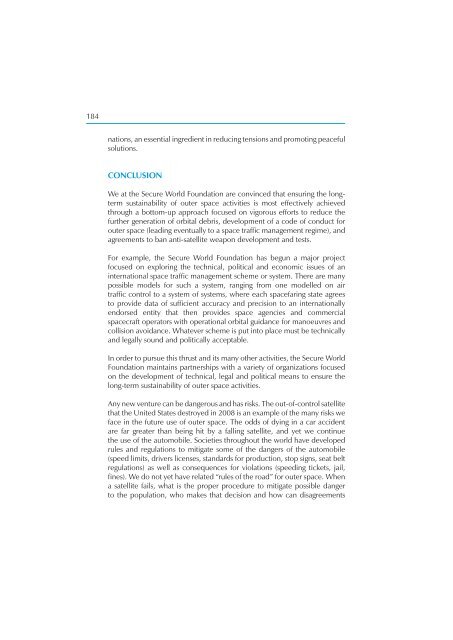Security in Space The Next Generation - UNIDIR
Security in Space The Next Generation - UNIDIR
Security in Space The Next Generation - UNIDIR
Create successful ePaper yourself
Turn your PDF publications into a flip-book with our unique Google optimized e-Paper software.
184<br />
nations, an essential <strong>in</strong>gredient <strong>in</strong> reduc<strong>in</strong>g tensions and promot<strong>in</strong>g peaceful<br />
solutions.<br />
CONCLUSION<br />
We at the Secure World Foundation are conv<strong>in</strong>ced that ensur<strong>in</strong>g the longterm<br />
susta<strong>in</strong>ability of outer space activities is most effectively achieved<br />
through a bottom-up approach focused on vigorous efforts to reduce the<br />
further generation of orbital debris, development of a code of conduct for<br />
outer space (lead<strong>in</strong>g eventually to a space traffi c management regime), and<br />
agreements to ban anti-satellite weapon development and tests.<br />
For example, the Secure World Foundation has begun a major project<br />
focused on explor<strong>in</strong>g the technical, political and economic issues of an<br />
<strong>in</strong>ternational space traffi c management scheme or system. <strong>The</strong>re are many<br />
possible models for such a system, rang<strong>in</strong>g from one modelled on air<br />
traffi c control to a system of systems, where each spacefar<strong>in</strong>g state agrees<br />
to provide data of suffi cient accuracy and precision to an <strong>in</strong>ternationally<br />
endorsed entity that then provides space agencies and commercial<br />
spacecraft operators with operational orbital guidance for manoeuvres and<br />
collision avoidance. Whatever scheme is put <strong>in</strong>to place must be technically<br />
and legally sound and politically acceptable.<br />
In order to pursue this thrust and its many other activities, the Secure World<br />
Foundation ma<strong>in</strong>ta<strong>in</strong>s partnerships with a variety of organizations focused<br />
on the development of technical, legal and political means to ensure the<br />
long-term susta<strong>in</strong>ability of outer space activities.<br />
Any new venture can be dangerous and has risks. <strong>The</strong> out-of-control satellite<br />
that the United States destroyed <strong>in</strong> 2008 is an example of the many risks we<br />
face <strong>in</strong> the future use of outer space. <strong>The</strong> odds of dy<strong>in</strong>g <strong>in</strong> a car accident<br />
are far greater than be<strong>in</strong>g hit by a fall<strong>in</strong>g satellite, and yet we cont<strong>in</strong>ue<br />
the use of the automobile. Societies throughout the world have developed<br />
rules and regulations to mitigate some of the dangers of the automobile<br />
(speed limits, drivers licenses, standards for production, stop signs, seat belt<br />
regulations) as well as consequences for violations (speed<strong>in</strong>g tickets, jail,<br />
fi nes). We do not yet have related “rules of the road” for outer space. When<br />
a satellite fails, what is the proper procedure to mitigate possible danger<br />
to the population, who makes that decision and how can disagreements








